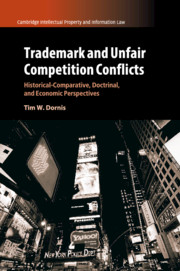Acknowledgments
My work in this field commenced almost ten years ago. At that time, I was sitting on the bench as a judge at the Regional Court of Stuttgart in Germany. In the beginning, it was little more than curiosity about the vexing problems in international trademark and unfair competition conflicts. However, it quickly became obvious that the complexity of the topic invited—indeed, required—an extensive scholarly endeavor and that my fascination (not to say obsession) strongly suggested a return to full-time academia. This is the path I took when I decided to transform my ideas into a book. In 2014, the manuscript was approved by the Faculty of Law at the University of Zurich (Switzerland) as a postdoctoral habilitation thesis. The text that was submitted for print is current as of December 2015.
I have presented ideas, concepts, and excerpts from this book at a number of conferences and other academic fora, including the 2008 and 2009 fellows’ sessions at the Stanford Program in International Legal Studies, the 2009 Stanford JSD colloquium, the 2009 Bay Area Fellows’ Intellectual Property and Technology Law Workshop at Berkeley University School of Law, the 2011 Habilitationskolloquium at the Max Planck Institute for Comparative and International Private Law, and the 2011 Global Fellow Forum sessions that I attended as a Global Fellow from Practice and Government at New York University School of Law. I am grateful for all the helpful comments I received on these and other occasions. In addition, I am indebted to my many colleagues and friends for enduring the discussions that I forced on them in recent years. I have benefited immensely from your collegiality, patience, and ideas.
My research abroad, notably as a fellow at the Stanford Program in International Legal Studies, was funded by the Deutsche Forschungsgemeinschaft with a full research scholarship. The Swiss National Science Foundation has generously supported an open-access publication of this book with a grant for the promotion of scholarly research.
In addition to these institutions, I owe particular thanks to my habilitation adviser, Andreas Heinemann (University of Zurich). First of all, I must thank him for giving me the chance to embark on such an ambitious project at a time when expectations were rather humble. He also served as an excellent mentor while providing me with the academic freedom necessary to develop my own ideas. Furthermore, I wish to thank Wolfgang Ernst (Oxford University), Franco Ferrari (New York University), and Beate Gsell (Ludwig-Maximilians-Universität of Munich) not only for being my role models from the time I was a young scholar but also for granting me valuable advice and words of encouragement along the way. Two other individuals who made an iconic imprint on me when I was their student are Barton Beebe (New York University) and Mark A. Lemley (Stanford University). They played a tremendous role in fostering and enhancing my modest understanding of intellectual property law in all its beauty.
I would also like to thank Matt Gallaway (Cambridge University Press) for his swift and professional handling of my manuscript submission, several anonymous peers for their helpful remarks during the review process, and the editors for accepting my book into the Cambridge Intellectual Property and Information Law Series. Furthermore, without Morgan Stoffregen’s editing and her most professional support throughout all stages of writing, this book would not have been possible. It goes without saying that any mistakes or oversights that remain are mine alone.
Finally, more than I can say, I am grateful to my wife, Christina, and our children, Josephine, Frederick, and Benedikt. Your love, patience, and understanding during the many times that I was away in the library (or present but still absent-minded) have been a miracle and the greatest gift of all.

